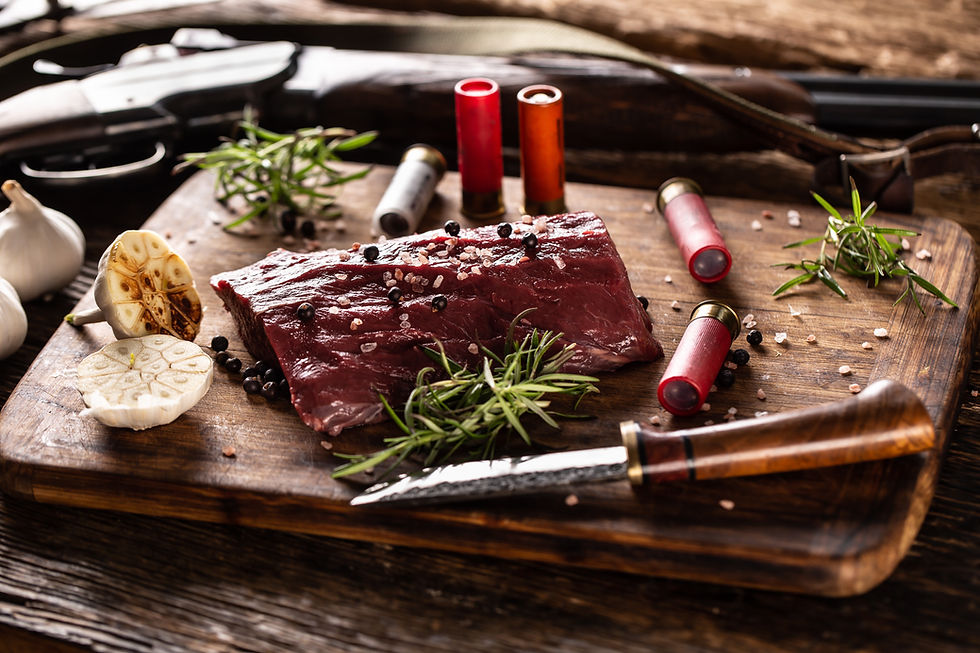How to Choose Which Species to Hunt First
- glenveenstra
- Mar 9, 2023
- 4 min read
What is the best species of animal to hunt for new hunters? This is a common question people ask when they’re just getting started in hunting.
To answer this question, we have to ask a few more questions. What’s the reason that you’re getting into hunting? What are you hoping to achieve by starting hunting? Some people are strictly hunting to procure meat for their families. Some people are hunting for a sense of adventure, and for many of us, it’s both.
We want meat for the freezer, a sense of adventure, and a connection to wild places where food comes from.
As a new hunter, if you're looking to develop your skills for the long term into a hunter that can consistently put meat on able, the choices you make at the beginning of your hunting career are going to drastically affect the learning curve to becoming a proficient hunter.
For example, let's strictly look at it from how much meat I can get out of a hunt. We will conclude that hunting elk, moose, or some huge animal and only having to kill one animal for a large amount of meat would be the best bet to put a lot of meat on the table quickly.

The problem is that hunting those larger animals is a challenging and very steep learning curve. If we haven’t developed some hunting skills beforehand, it won't be easy to succeed on those more extensive hunts right off the hop.
I suggest starting with something that you can get success at reasonably quickly. This could be as simple as hunting grouse, chucker, or rabbits. Anything that you can hunt or take one meal's worth of meat and put on the table and have that experience.
Becoming a successful hunter involves more than just walking into the woods and shooting something. The actual steps to a successful hunt look something like this:
Prepare for the hunt: Scout online if applicable, prepare your gear, decide where you’re going, and make a plan.
Get into the woods and actually start hunting the game you’re after.
Learn how to locate animals better through experience in the woods.
Take a shot at a bird or animal.
Learn from your mistakes when you inevitably miss one.
Potentially blood trail the animal you shot if you didn’t see it die.
Learn from your mistakes if you made a bad shot and had to follow a very long blood trail.
Field dress the animal to preserve the maximum amount of meat.
Pack the meat out to a cool storage location. This could be a cooler or fridge if you’re close to home. At certain times of the year, it’s cool enough outside.
Butcher the animal into cuts of meat that are table ready.
Cook and serve delicious wild meat.

Really take a look at the above list. If you’re not starting your hunting career in a game-rich environment that allows plenty of opportunity for getting shots at animals, you could spend years only getting to step 3. There are eight more steps to becoming successful that you’re missing out on!
I’m especially aware of this when teaching kids how to hunt. With a shorter attention span than adults, we need to be mindful that kids want to see success early on. Early success gives us so much confidence moving forward.
When I’m taking kids out hunting for the first time, I take them somewhere that I am very confident they can succeed their first time out. This gives them a sense of pride and accomplishment and keeps them coming back.
We’re no different from kids that way. We want that sense of pride and accomplishment that comes from success.
The best way to get better at harvesting wild game, is to harvest more wild game.
So what steps should you take to get out on that first hunt?
1
Do some research on what wild game is abundant in your area and has the option for you to get tags that allow you to harvest multiple animals or birds. For big game, this may look like a hunting unit that has a second deer tag, allowing you two opportunities for the year. For bird hunting, it may look like a grouse license with a daily limit of 4 birds/per day.
2
Narrow down a specific hunting location as close to home as possible where you can hunt the species you’ve identified in step one. This is important because the closer to home you can hunt, the more times you’re likely to get into the field. Whether you’re brand new to hunting, or a seasoned vet, the number one factor that determines success on ANY hunt is time in the field.
3
Harvest an animal, and repeat steps 1 and 2 as often as possible.
For more information on planning your first hunt, download this 10-step guide to planning your first hunt, or check out my top 3 big game hunting trips for new hunters.
Time to get out there and find some success. Don’t overthink it. Remember, time in the field is the number one factor that determines success. So hunt hard and hunt as often as you can. You’ll learn more in one season of hands-on experience than in 5 years of researching online.



Comments